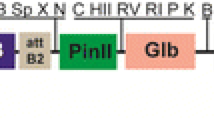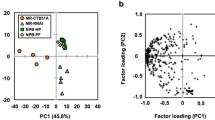Abstract
Cholera toxin B subunit (CTB) is widely used as a carrier molecule and mucosal adjuvant and for the expression of fusion proteins of interest. CTB-fusion proteins are also expressed in plants, but the N-glycan structures of CTB have not been clarified. To gain insights into the N-glycosylation and N-glycans of CTB expressed in plants, we expressed CTB in rice seeds with an N-terminal glutelin signal and a C-terminal KDEL sequence and analyzed its N-glycosylation and N-glycan structures. CTB was successfully expressed in rice seeds in two forms: a form with N-glycosylation at Asn32 that included both plant-specific N-glycans and small oligomannosidic N-glycans and a non-N-glycosylated form. N-Glycan analysis of CTB showed that approximately 50 % of the N-glycans had plant-specific M3FX structures and that almost none of the N-glycans was of high-mannose-type N-glycan even though the CTB expressed in rice seeds contains a C-terminal KDEL sequence. These results suggest that the CTB expressed in rice was N-glycosylated through the endoplasmic reticulum (ER) and Golgi N-glycosylation machinery without the ER retrieval.





Similar content being viewed by others
References
De Haan, L., & Hirst, T. R. (2004). Cholera toxin: A paradigm for multi-functional engagement of cellular mechanisms (review). Molecular Membrane Biology, 21, 77–92.
Zhang, R. G., Scott, D. L., Westbrook, M. L., Nance, S., Spangler, B. D., Shipley, G. G., et al. (1995). The three dimensional crystal structure of cholera toxin. Journal of Molecular Biology, 251, 563–573.
Zhang, R. G., Westbrook, M. L., Westbrook, E. M., Scott, D. L., Otwinowski, Z., Maulik, P. R., et al. (1995). The 2.4 Angstrom crystal structure of cholera toxin B subunit pentamer: Choleragenoid. Journal of Molecular Biology, 251, 550–562.
Sanchez, J., & Holmgren, J. (2011). Cholera toxin—a foe & a friend. Indian Journal of Medical Research, 133, 153–163.
Soria-Guerra, R. E., Moreno-Fierros, L., & Rosales-Mendoza, S. (2011). Two decades of plant-based candidate vaccines: A review of the chimeric protein approaches. Plant Cell Reports, 30, 1367–1382.
Chen, M., Liu, X., Wang, Z., Song, J., Qi, Q., & Wang, P. G. (2005). Modification of plant N-glycans processing: The future of producing therapeutic protein by transgenic plants. Medicinal Research Reviews, 25, 343–360.
Hellwig, S., Drossard, J., Twyman, R. M., & Fischer, R. (2004). Plant cell cultures for the production of recombinant proteins. Nature Biotechnology, 22, 1415–1422.
Horn, M. E., Woodard, S. L., & Howard, J. A. (2004). Plant molecular farming: Systems and products. Plant Cell Reports, 22, 711–720.
Basaran, P., & Rodríguez-Cerezo, E. (2008). Plant molecular farming: Opportunities and challenges. Critical Reviews in Biotechnology, 28, 153–172.
Daniell, H., Streatfield, S. J., & Wycoff, K. (2001). Medical molecular farming: Production of antibodies, biopharmaceuticals and edible vaccines in plants. Trends in Plant Science, 6, 219–226.
Dove, A. (2002). Uncorking the biomanufacturing bottleneck. Nature Biotechnology, 20, 777–779.
Daniell, H., Lee, S. B., Panchal, T., & Wiebe, P. O. (2001). Expression of the native cholera toxin B subunit gene and assembly as functional oligomers in transgenic tobacco chloroplasts. Journal of Molecular Biology, 311, 1001–1009.
Matoba, N., Kajiura, H., Cherni, I., Doran, J. D., Bomsel, M., Fujiyama, K., et al. (2009). Biochemical and immunological characterization of the plant-derived candidate human immunodeficiency virus type 1 mucosal vaccine CTB–MPR649–684. Plant Biotechnology Journal, 7, 129–145.
Oszvald, M., Kang, T. J., Tomoskozi, S., Jenes, B., Kim, T. G., Cha, Y. S., et al. (2008). Expression of cholera toxin B subunit in transgenic rice endosperm. Molecular Biotechnology, 40, 261–268.
Takagi, H., Hiroi, T., Yang, L., Takamura, K., Ishimitsu, R., Kawauchi, H., et al. (2008). Efficient induction of oral tolerance by fusing cholera toxin B subunit with allergen-specific T-cell epitopes accumulated in rice seed. Vaccine, 26, 6027–6030.
Arakawa, T., Chong, D. K., Merritt, J. L., & Langridge, W. H. (1997). Expression of cholera toxin B subunit oligomers in transgenic potato plants. Transgenic Research, 6, 403–413.
Kim, T. G., & Langridge, W. H. (2003). Assembly of choleratoxin B subunit full-length rotavirus NSP4 fusion protein oligomers in transgenic potato. Plant Cell Reports, 21, 884–890.
Choi, N. W., Estes, M. K., & Langridge, W. H. (2005). Synthesis and assembly of a cholera toxin B subunit-rotavirus VP7 fusion protein in transgenic potato. Molecular Biotechnology, 31, 193–202.
Ruhlman, T., Ahangari, R., Devine, A., Samsam, M., & Daniell, H. (2007). Expression of cholera toxin B-proinsulin fusion protein in lettuce and tobacco chloroplasts–oral administration protects against development of insulitis in non-obese diabetic mice. Plant Biotechnology Journal, 5, 495–510.
Huy, N. X., Yang, M. S., & Kim, T. G. (2011). Expression of a cholera toxin B subunit-neutralizing epitope of the porcine epidemic diarrhea virus fusion gene in transgenic lettuce (Lactuca sativa L.). Molecular Biotechnology, 48, 201–209.
Rayon, C., Lerouge, P., & Faye, L. (1998). The protein N-glycosylation in plant. Journal of Experimental Botany, 49, 1463–1472.
Wilson, I. B. (2002). Glycosylation of proteins in plants and invertebrates. Current Opinion in Structural Biology, 12, 569–577.
Brooks, S. A. (2004). Appropriate glycosylation of recombinant proteins for human use: Implications of choice of expression system. Molecular Biotechnology, 28, 241–255.
Tomiya, N., Narang, S., Lee, Y. C., & Betenbaugh, M. J. (2004). Comparing N-glycan processing in mammalian cell lines to native and engineered lepidopteran insect cell lines. Glycoconjugate Journal, 21, 343–360.
Pattison, R. J., & Amtmann, A. (2009). N-glycan production in the endoplasmic reticulum of plants. Trends in Plant Science, 14, 92–99.
Fitchette-Lainé, A. C., Gomord, V., Cabanes, M., Michalski, J. C., Saint, Macary, M., et al. (1997). N-Glycans harboring the Lewis a epitope are expressed at the surface of plant cells. The Plant Journal, 12, 1411–1417.
Strasser, R., Bondili, J. S., Vavra, U., Schoberer, J., Svoboda, B., Glössl, J., et al. (2007). A unique β1,3-galactosyltransferase is indispensable for the biosynthesis of N-glycans containing Lewis a structures in Arabidopsis thaliana. The Plant Cell, 19, 2278–2292.
van Ree, R., Cabanes-Macheteau, M., Akkerdaas, J., Milazzo, J. P., Loutelier-Bourhis, C., Rayon, C., et al. (2000). β(1,2)-xylose and α(1,3)-fucose residues have a strong contribution in IgE binding to plant glycoallergens. The Journal of Biological Chemistry, 275, 11451–11458.
Altmann, F. (2007). The role of protein glycosylation in allergy. International Archives of Allergy and Immunology, 142, 99–115.
Jin, C., Altmann, F., Strasser, R., Mach, L., Schähs, M., Kunert, R., et al. (2008). A plant-derived human monoclonal antibody induces an anti-carbohydrate immune response in rabbits. Glycobiology, 18, 235–241.
Nochi, T., Takagi, H., Yuki, Y., Yang, L., Masumura, T., Mejima, M., et al. (2007). Rice-based mucosal vaccine as a global strategy for cold-chain- and needle-free vaccination. Proceedings of the National Academy of Sciences of the United States of America, 104, 10986–10991.
le Qu, Q., & Takaiwa, F. (2004). Evaluation of tissue specificity and expression strength of rice seed component gene promoters in transgenic rice. Plant Biotechnology Journal, 2, 113–125.
Sugita, K., Kasahara, S., Ebinuma, H., Takaiwa, H., Jomori, T., Hayashi, Y., Tashita, A., & Kobara, Y. (2004). Process for producing plant storage organ with high production of recombinant protein and novel recombinant protein. Patent 371 WO 04/087910.
Sugita, K., Endo-Kasahara, S., Tada, Y., Lijun, Y., Yasuda, H., Hayashi, Y., et al. (2005). Genetically modified rice seeds accumulating GLP-1 analogue stimulate insulin secretion from a mouse pancreatic beta-cell line. FEBS Letters, 579, 1085–1088.
Yang, L., Kajiura, H., Suzuki, K., Hirose, S., Fujiyama, K., & Takaiwa, F. (2008). Generation of a transgenic rice seed-based edible vaccine against house dust mite allergy. Biochemical and Biophysical Research Communications, 365, 334–339.
Misaki, R., Kimura, Y., Fujiyama, K., & Seki, T. (2001). Glycoproteins secreted from suspension-cultured tobacco BY2 cells have distinct glycan structures from intracellular glycoproteins. Bioscience, Biotechnology, and Biochemistry, 65, 2482–2488.
Kajiura, H., Seki, T., & Fujiyama, K. (2010). Arabidopsis thaliana ALG3 mutant synthesizes immature oligosaccharides in the ER and accumulates unique N-glycans. Glycobiology, 20, 736–751.
Pagny, S., Bouissonnie, F., Sarkar, M., Follet-Gueye, M. L., Driouich, A., Schachter, H., et al. (2003). Structural requirements for Arabidopsis β1,2-xylosyltransferase activity and targeting to the Golgi. Plant Journal, 33, 189–203.
Bencúr, P., Steinkellner, H., Svoboda, B., Mucha, J., Strasser, R., Kolarich, D., et al. (2005). Arabidopsis thaliana β1,2-xylosyltransferase: An unusual glycosyltransferase with the potential to act at multiple stages of the plant N-glycosylation pathway. Biochemical Journal, 388, 515–525.
Kajiura, H., Okamoto, T., Misaki, R., Matsuura, Y., & Fujiyama, K. (2011). Arabidopsis β1,2-xylosyltransferase: Substrate specificity and participation in the plant-specific N-glycosylation pathway. Journal of Bioscience and Bioengineering, 113, 48–54.
Yang, D. C., Guo, F. L., Liu, B., Huang, N., & Watkins, S. C. (2003). Expression and localization of human lysozyme in the endosperm of transgenic rice. Planta, 216, 597–603.
Chikwamba, R. K., Scott, M. P., Mejía, L. B., Mason, H. S., & Wang, K. (2003). Localization of a bacterial protein in starch granules of transgenic maize kernels. Proceedings of the National Academy of Sciences of the United States of America, 100, 11127–11132.
Kim, T. G., Kim, B. G., Kim, M. Y., Choi, J. K., Jung, E. S., & Yang, M. S. (2010). Expression and immunogenicity of enterotoxigenic Escherichia coli heat-labile toxin B subunit in transgenic rice callus. Molecular Biotechnology, 44, 14–21.
Nicholson, L., Gonzalez-Melendi, P., van Dolleweerd, C., Tuck, H., Perrin, Y., Ma, J. K., et al. (2005). A recombinant multimeric immunoglobulin expressed in rice shows assembly-dependent subcellular localization in endosperm cells. Plant Biotechnology Journal, 3, 115–127.
Gomord, V., Fitchette, A. C., Menu-Bouaouiche, L., Saint-Jore-Dupas, C., Plasson, C., Michaud, D., et al. (2010). Plant-specific glycosylation patterns in the context of therapeutic protein production. Plant Biotechnology Journal, 8, 564–587.
Zhang, D., Nandi, S., Bryan, P., Pettit, S., Nguyen, D., Santos, M. A., et al. (2010). Expression, purification, and characterization of recombinant human transferrin from rice (Oryza sativa L.). Protein Expression and Purification, 74, 69–79.
Fujiyama, K., Sakai, Y., Misaki, R., Yanagihara, I., Honda, T., Anzai, H., et al. (2004). N-linked glycan structures of human lactoferrin produced by transgenic rice. Bioscience, Biotechnology, and Biochemistry, 68, 2565–2570.
Nandi, S., Yalda, D., Lu, S., Nikolov, Z., Misaki, R., Fujiyama, K., et al. (2005). Process development and economic evaluation of recombinant human lactoferrin expressed in rice grain. Transgenic Research, 14, 237–249.
de Halleux, S., Stura, E., VanderElst, L., Carlier, V., Jacquemin, M., & Saint-Remy, J. M. (2006). Three-dimensional structure and IgE-binding properties of mature fully active Der p 1, a clinically relevant major allergen. Journal of Allergy and Clinical Immunology, 117, 571–576.
Chruszcz, M., Chapman, M. D., Vailes, L. D., Stura, E. A., Saint-Remy, J. M., Minor, W., et al. (2009). Crystal structures of mite allergens Der f 1 and Der p 1 reveal differences in surface-exposed residues that may influence antibody binding. Journal of Molecular Biology, 386, 520–530.
Author information
Authors and Affiliations
Corresponding author
Rights and permissions
About this article
Cite this article
Kajiura, H., Wasai, M., Kasahara, S. et al. N-Glycosylation and N-Glycan Moieties of CTB Expressed in Rice Seeds. Mol Biotechnol 54, 784–794 (2013). https://doi.org/10.1007/s12033-012-9626-4
Published:
Issue Date:
DOI: https://doi.org/10.1007/s12033-012-9626-4




